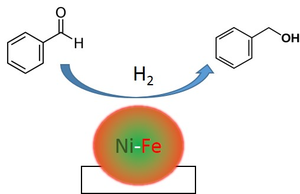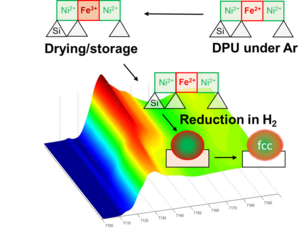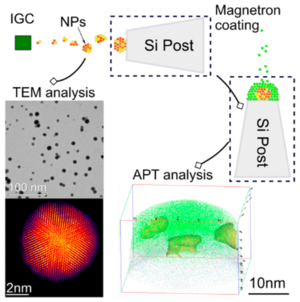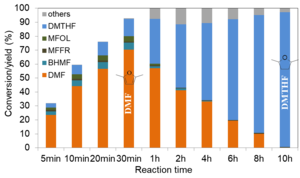Articles
Published articles and highlights
Review

Compared with Ni monometallic catalysts, Fe-Ni catalysts are interesting systems for the hydrogenation of organic molecules, in terms of activity or selectivity. This review presents a survey of the literature on this topic, underlines the catalytic performances of some formulations, and summarizes the questions that remain open on the link between the composition of the Fe-Ni nanoparticles and their catalytic activity.
Ni promotion by Fe: what benefits for catalytic hydrogenation? – D. Shi, R. Wojcieszak, S. Paul, E. Marceau – Catalysts, 9, 451-479 (2019).
Article

During his PhD at UCCS (defended in September 2019), Dichao Shi has explored the synthesis of Fe-Ni/SiO2 catalysts by deposition-precipitation with urea, and has evidenced, in particular using advanced characterization methods (in situ X-ray absorption spectroscopy and Mössbauer spectroscopy):
(i) the whole formation process of Fe-Ni bimetallic nanoparticles
(ii) the homogeneity of the nanoparticles in structure, size and overall composition
(iii) the likely presence on an excess of iron at the surface of the reduced nanoparticles
(iv), the higher selectivity in furfuryl alcohol of a Fe-Ni/SiO2 catalyst in the hydrogenation of furfural, compared with an analogue monometallic nickel catalyst.
Bimetallic Fe-Ni/SiO2 catalysts for furfural hydrogenation: Identification of the interplay between Fe and Ni during deposition-precipitation and thermal treatments – D. Shi, Q. Yang, C. Peterson, A. F. Lamic-Humblot, J. S. Girardon, A. Griboval-Constant, L. Stievano, M. T. Sougrati, V. Briois, P. A. J. Bagot, R. Wojcieszak, S. Paul, E. Marceau* – Catalysis Today, 339, 162-172 (2019).
https://doi.org/10.1016/j.cattod.2018.11.041
This work was done in collaboration with the Department of Materials of the University of Oxford, the Laboratoire de Réactivité de Surface (Sorbonne Université, Paris), synchrotron SOLEIL and the Institut Charles Gerhardt de Montpellier.
Article

A question underlying the NobleFreeCat project concerns the development of methodologies that provide evidence of the relative localization of two metals within bimetallic nanoparticles. The nanostructure and heterogeneities of Au-Cu nanoparticles, prepared by condensation in the gas phase and protected from oxidation by silver encapsulation, can thus be evidenced by atom-probe tomography.
Atom probe tomography of Au–Cu bimetallic nanoparticles synthesized by inert gas condensation - Q. Yang,* M. Danaie, N. Young, V. Broadley, D. E. Joyce, T. L. Martin, E. Marceau, M. P. Moody, P. A. J. Bagot – Journal of Physical Chemistry C, 123, 26481-26489 (2019).
https://doi.org/10.1021/acs.jpcc.9b09340
This work was done in collaboration with the Department of Materials of the University of Oxford.
Article

Furfural is the molecule that has been selected for the first hydrogenation tests on bimetallic particles during the NobleFreeCat project. During Shuo Chen’s PhD (defended in May 2019), the UCCS and IC2MP teams have also initiated tests on a molecule of the same family but deriving from glucose, 5-hydroxymethylfurfural (5-HMF). Monometallic Ni/SBA-15 catalysts have proved to be selective systems in the hydrogenolysis of this molecule, successively yielding two molecules that can be used as biofuels: 2,5-dimethylfuran (DMF) and 2,5-dimethyltetrahydrofuran (DMTHF).
Hydroconversion of 5‐hydroxymethylfurfural to 2,5‐dimethylfuran and 2,5‐dimethyltetrahydrofuran over non‐promoted Ni/SBA‐15 – S. Chen, C. Ciotonea, K. De Oliveira Vigier, F. Jérôme, R. Wojcieszak, F. Dumeignil, E. Marceau,* S. Royer* – ChemCatChem, 12, 2050-2059 (2020).

![[Translate to English:] Unité de Catalyse et Chimie du Solide (UMR 8181 CNRS) [Translate to English:] Logo Unité de Catalyse et Chimie du Solide (UMR 8181 CNRS)](/fileadmin/_processed_/0/3/csm_uccs_317e8e4595.png)
![[Translate to English:] Laboratoire de Chimie de Coordination (UPR 8241 CNRS) [Translate to English:] Logo Laboratoire de Chimie de Coordination (UPR 8241 CNRS)](/fileadmin/_processed_/c/1/csm_lcc_10fbb46c62.png)

![[Translate to English:] Laboratoire de Chimie Physique (UMR 8000 CNRS) [Translate to English:] Logo Laboratoire de Chimie Physique (UMR 8000 CNRS)](/fileadmin/_processed_/9/a/csm_logoicp_10d5d93dba.png)